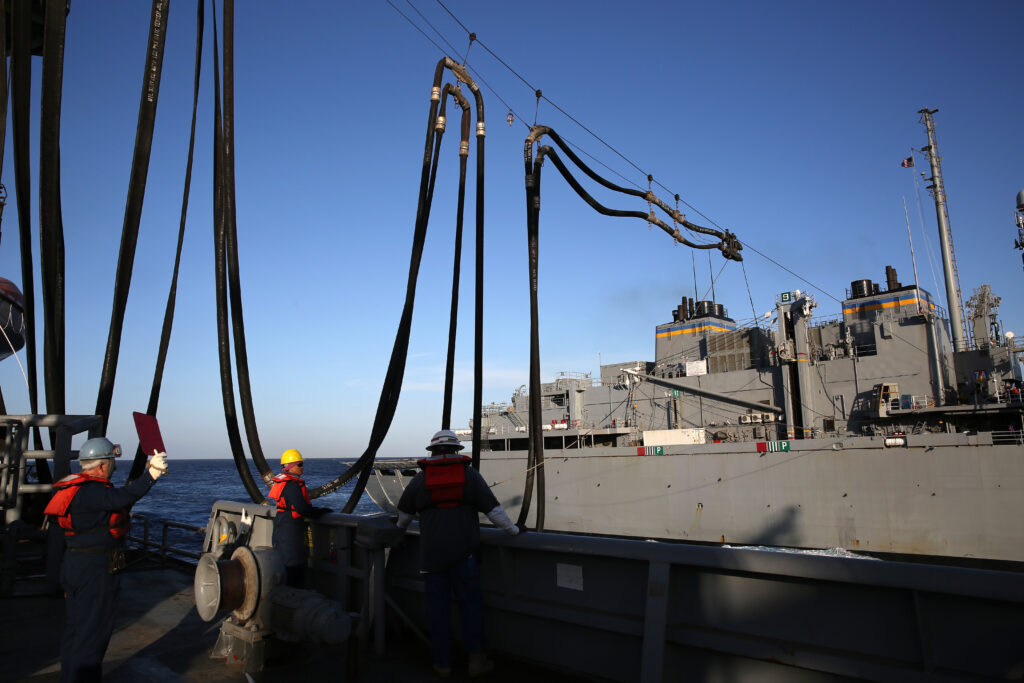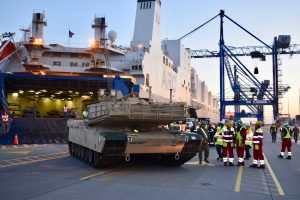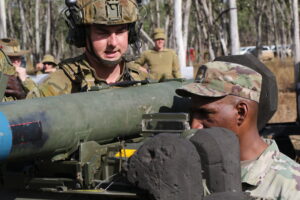
A Navy oil tanker runs a fuel line to another ship during a “replenishment at sea.”
WASHINGTON: While other panels get to announce high-tech, high-profile projects like nuclear submarines and AI research, the House Armed Services subcommittee on readiness talks logistics. In particular, their piece of the annual defense policy bill – passed by the subcommittee today, but still many months and amendments from being voted into law – demands reports and briefings from top Pentagon officials on some grittily practical topics with strategic implications around the world.

A US Army M1 Abrams heavy tank unloads from a transport ship in Poland.
As the Army reorients from counterinsurgency to Russia, its new concept for combat, Multi-Domain Operations, relies heavily on high-level headquarters to coordinate large-scale battle. So the service is reactivating its storied V Corps HQ to help run operations in Europe. But while elements of the headquarters will regularly deploy to Europe, they’ll be based in Kentucky. Normally legislators prefer troops to be based in their districts rather than abroad, but the HASC readiness subcommittee is questioning this decision. It wants Army Secretary Ryan McCarthy to report by October 30th on why the service chose to put V Corps HQ at Fort Knox instead of overseas, what the financial and tactical costs might be, what infrastructure is available on both sides of the Atlantic, and whether the Army might change its mind.
The subcommittee is also skeptical about the Army’s ability to keep two-thirds percent of its active-duty combat brigades (and one third of its National Guard ones) at high readiness indefinitely. While the Army’s made major progress repairing readiness after Budget Control Act cuts, “the committee is concerned that training requirements needed to maintain high levels of readiness for a large portion of the Army may not be sustainable and could place an unnecessary strain on the force.” Army Forces Command, which runs combat brigade training, is conducting its own review of the new “Sustainable Readiness Model,” and the subcommittee is asking Army Chief of Staff Gen. James McConville to provide that review’s recommendations and the cost of potential changes by March 1 next year.
Meanwhile, recently confirmed Navy Secretary Kenneth Braithwaite would owe the readiness subcommittee a report on military’s ability to supply bulk fuel to its far-flung forces across the vast Pacific theater. Until that report’s delivered, the Navy would not be allowed to spend any money for new bulk fuel storage in the Indo-Pacific Command area. While the Navy’s premier vessels – its aircraft carriers and submarines – are nuclear-powered, the rest of its ships consume vast quantities of fuel, as do its carrier-launched and shore-based air fleets. The Marine Corps Commandant, Gen. David Berger, has already publicly worried that US shipyards couldn’t repair and replace damaged ships as fast as China’s in the event of war. But an even bigger logistical Achilles’ Heel would be insufficient fuel, which could take ships out of action without the enemy firing a shot. The HASC language warns that the number of US-flagged oil tankers is dropping, foreign-flagged tankers are unreliable in a time of conflict, and responsibility for buying and delivering bulk fuel is split between Pentagon organizations when it should be under “a single organizational element.”

An Australian soldier explains his RBS-70 anti-aircraft weapon to a visiting US Army officer during the two countries’ combined Talisman Saber 2019 wargames.
A separate provision would also order the Defense Secretary to submit a master plan for building up basing infrastructure in northern Australia, a longtime ally that’s becoming increasingly important to containing China.
Of course, the military depends on basing infrastructure, fossil fuels and other logistical essentials worldwide, not just in the Pacific. So the most ambitious report the readiness subcommittee wants to create is a quadrennial “comprehensive review of the sustainment and logistics requirements necessary” to implement all aspects of the National Defense Strategy over periods of five, 10 and 25 years. (The Pentagon’s already required by law to come up with a new National Defense Strategy every four years; the new ‘National Defense Sustainment and Logistics Review” would come two years after each NDS). The Office of the Secretary of Defense would be responsible for this recurring mega-report, consulting with all the armed services, Transportation Command and the Defense Logistics Agency.
The Defense Secretary would also have to deliver a one-time report on energy strategy, including reducing the department’s fossil fuel consumption worldwide “by not less than 10 percent in 10 years and 30 percent in 25 years.” As the subcommittee points out, attacks on vulnerable fuel convoys caused as many as 70 percent of US casualties in Afghanistan and Iraq, but the military’s only begun to try to reduce that vulnerability. Now, there’s also a partisan angle here: Democrats see reducing military consumption of fossil fuels as a way to combat global warming and advance alternative energy, which Republicans (especially from oil states) see as complicating military operations for a political agenda. So this request for a strategy may not survive conference negotiations with the Republican-led Senate – although its odds are better than a provision actually requiring the Defense Department to make a change.
It’s worth noting that the draft language released so far doesn’t include any specific figures for funding — those will be released later.

Rep. Doug Lamborn
The subcommittee’s draft will be marked up and voted on by the full House Armed Services Committee on July 1st. The National Defense Authorization Act must then pass the House and be reconciled with the Senate version.
But the most painful question is probably not coming up until next year. That’s when the country will (hopefully) emerge from the COVID-19 pandemic to survey the economic damage. And while COVID is currently driving emergency plus-ups to defense spending, at least some senior defense leaders are already publicly contemplating potential post-pandemic cuts. Those will require painful trade-offs between buying high-tech new weapons, sustaining the size of the existing force, and keeping that force as trained and ready as possible.
“The return of great power competition with China and Russia has revealed the need for the U.S. military to invest in new technologies as our primacy in domains such as cyber, space, and precision weapons is no longer guaranteed,” warned the top Republican on the readiness subcommittee, Rep. Doug Lamborn. “At the same time, our ability to meet today’s threats, whether it is defeating terrorist organizations, deterring adversaries, or responding to aggression all hinge on today’s readiness. We must get this balance right.”
Move over FARA: General Atomics pitching new Gray Eagle version for armed scout mission
General Atomics will also showcase its Mojave demonstrator for the first time during the Army Aviation Association of America conference in Denver, a company spokesman said.


























